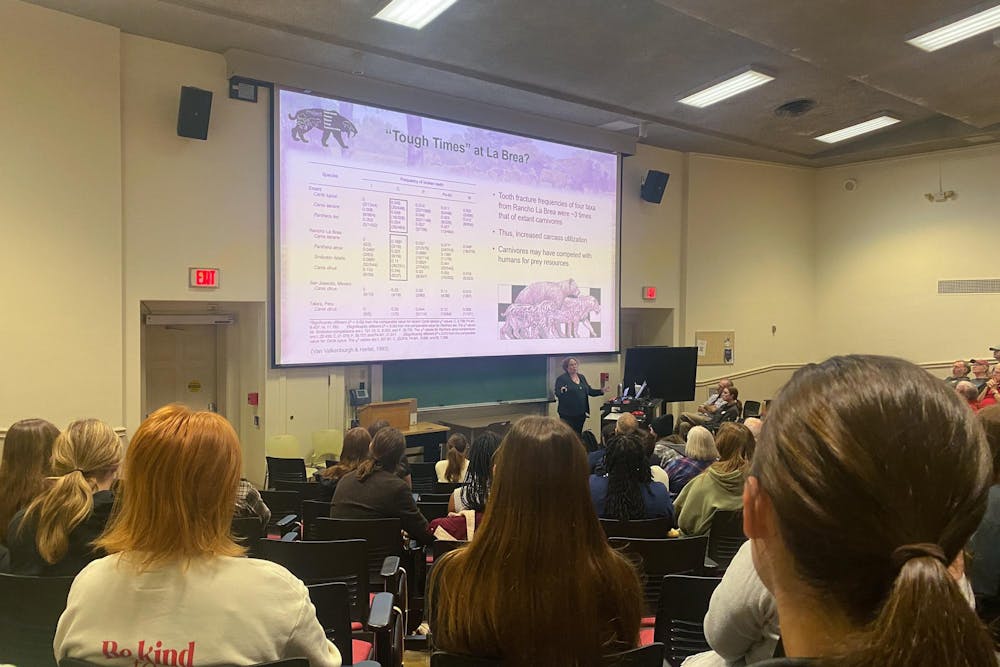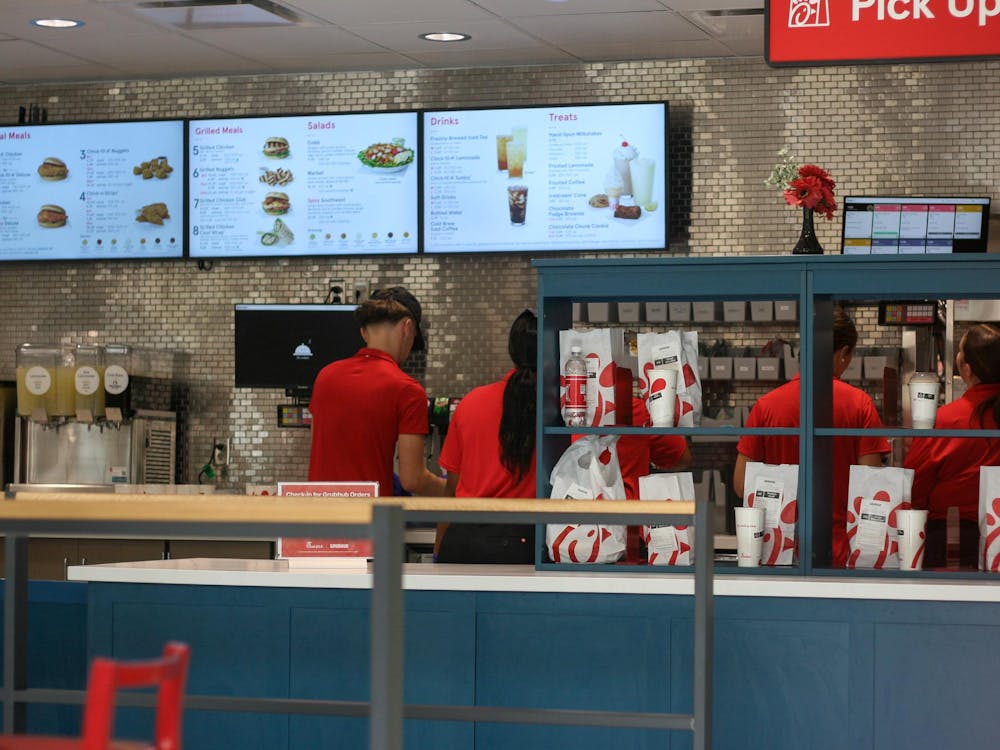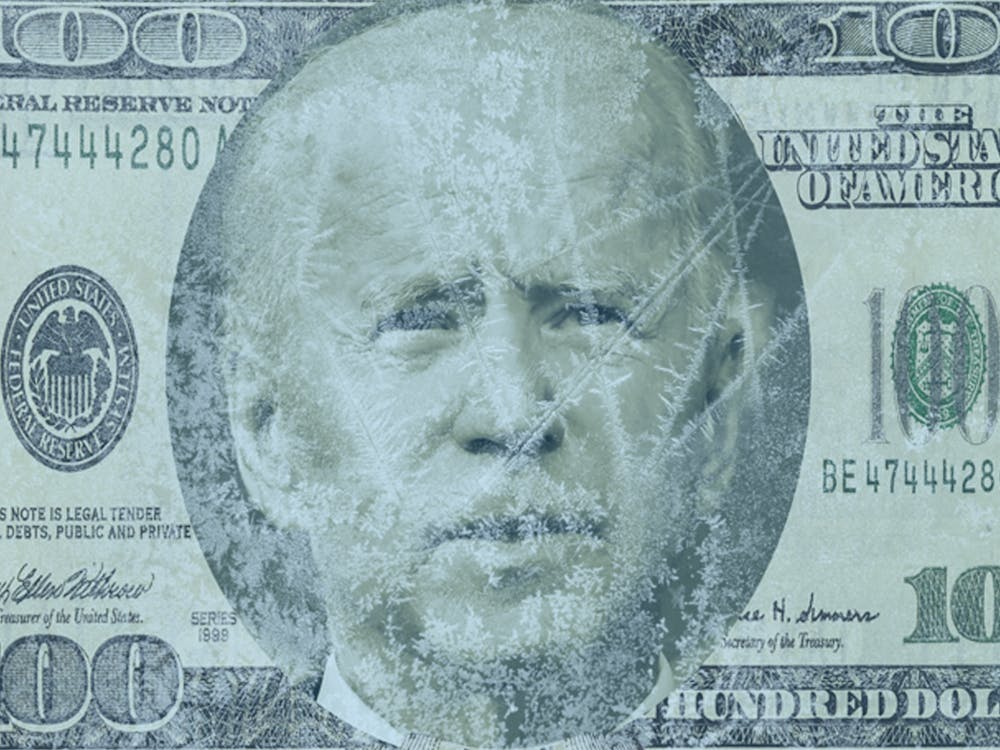Larisa DeSantis, a vertebrate paleontologist, spoke at Miami University at 7:30 p.m. on Thursday, Oct. 16, for the 51st annual Hefner Lecture. During the lecture, DeSantis discussed her research on saber-tooth cats, dire wolves, coyotes and pizzly bears.
Steven Sullivan, director of the Hefner Museum of Natural History, started the lecture by noting the importance of this event and how it aligns with the mission of the museum – to connect people to nature.
Sullivan said the annual Hefner Lecture officially began 51 years ago, but before that, Miami professors brought in scientists from across the nation to talk in kitchens and parlors about various scientific topics. Fifty-one years ago, these conversations were opened to the public to enjoy and learn from.
DeSantis started presenting her research by introducing her connection to science, animals and nature.
“We have a solid understanding and knowledge [that] climate change is real,” DeSantis said. “My aim is to clarify biotic responses to climate change, and how animals and plants are responding with climate change.”
Much of DeSantis’ research focused on the La Brea Tar pits, an active research site and museum in Los Angeles.
DeSantis said that La Brea represents the last 50,000 years of history. During this time, the climate changed, people came into the landscape and some animals went extinct.
“The La Brea Tar Pits [are] a really special place,” DeSantis said. “In part, because of the fact that it's a ‘tar’ seep so it traps animals in a unique way, much like flies on flood paper.”
She went on to discuss how teeth and morphology can reveal a lot about the extinction of many prehistoric animals. She said the chemistry of the teeth can help scientists understand what animals were eating. For example, some animals were eating grass and flesh, while others ate seeds, tubers and bones.
DeSantis presented a data graph of broken teeth in animals she has studied and how it could reveal how they lived at La Brea. The graph showed that for modern wolves, coyotes and lions, only about 5% of the teeth are broken. However, fossil coyotes, American lions, saber-toothed cats and dire wolves had higher rates of 10% to 30% of canines broken.
The idea of “tough times” came about following a paper published by Blaire Van Valkenburgh in 1993 that cited the animals at La Brea must have been competing with humans for prey, resulting in the broken canines. Through her research, DeSantis said she questioned this theory because of the lack of stress indicators to prove this and her findings that many predators' teeth were more likely to have been broken through hunting larger prey.
Lastly, DeSantis covered the idea of hybridization and that the polar bear and grizzly bear hybrid – a “pizzly” or “grolar” bear – may be bringing hope for the polar bear species in a warming climate. She said the hybrid may be able to withstand the weather changes and expand its diet to survive.
Enjoy what you're reading?
Signup for our newsletter
DeSantis ended with a message that tied up the purpose of her research.
“It's really important to study our past, and whether that be our historic past or prehistoric past, it's important to understand the context of different ways that things are changing,” DeSantis said. “I also want to end with the importance of museums such as this, where the collection is saved when you study. You never know what new technologies and new techniques can bring to studying old specimens and telling new stories.”
Katie Middleton, a junior biology major, said she attended the lecture last year and loves that she learns something new every time she goes.
“This time around, I didn't even know what a pizzly bear was.” Middleton said, “So it's kind of interesting to learn what that was and that they're fertile, which is amazing because you never really see animals like hybrids that are fertile.”
Ashley Sideri, a junior zoology major, said she heard about the lecture when DeSantis came to her mammalogy class, BIO 510.
“It’s inspiring that we can use the past to predict the future,” Sideri said. “There's so much information you can unpack from the past in order to help conserve the species today.”
After the lecture, Sullivan invited the audience to a reception in the Hefner museum, where new taxidermy specimens were unveiled, such as a polar bear and saber-tooth cat.




